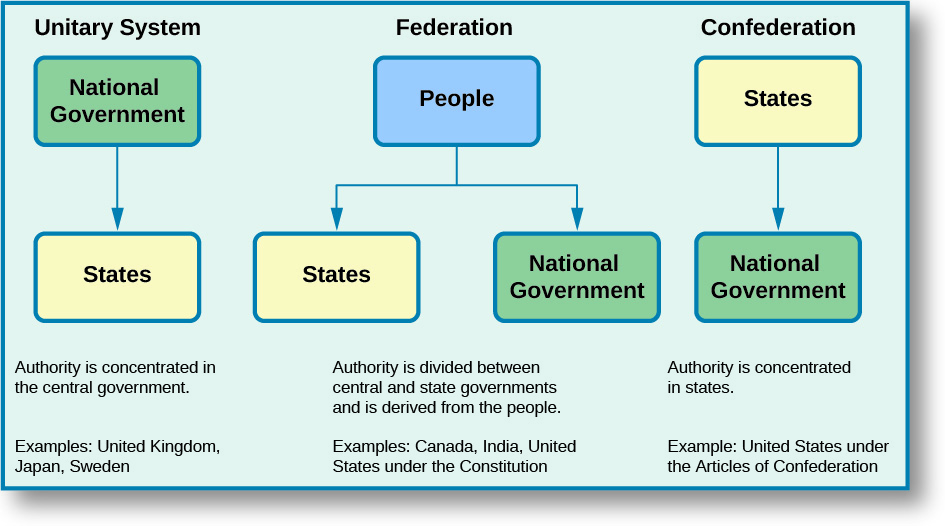FEDERALISM DEFINED AND CONTRASTED
Federalism is an institutional arrangement that creates two relatively autonomous levels of government, each possessing the capacity to act directly on behalf of the people with the authority granted to it by the national constitution.See John Kincaid. 1975. “Federalism.” In Civitas: A Framework for Civil Education, eds. Charles Quigley and Charles Bahmueller. Calabasas, CA: Center for Civic Education, 391–392; William S. Riker. 1975. “Federalism.” In Handbook of Political Science, eds. Fred Greenstein and Nelson Polsby. Reading, MA: Addison-Wesley, 93–172. Although today’s federal systems vary in design, five structural characteristics are common to the United States and other federal systems around the world, including Germany and Mexico.
First, all federal systems establish two levels of government, with both levels being elected by the people and each level assigned different functions. The national government is responsible for handling matters that affect the country as a whole, for example, defending the nation against foreign threats and promoting national economic prosperity. Subnational, or state governments, are responsible for matters that lie within their regions, which include ensuring the well-being of their people by administering education, health care, public safety, and other public services. By definition, a system like this requires that different levels of government cooperate, because the institutions at each level form an interacting network. In the U.S. federal system, all national matters are handled by the federal government, which is led by the president and members of Congress, all of whom are elected by voters across the country. All matters at the subnational level are the responsibility of the fifty states, each headed by an elected governor and legislature. Thus, there is a separation of functions between the federal and state governments, and voters choose the leader at each level.Garry Willis, ed. 1982. The Federalist Papers by Alexander Hamilton, James Madison and John Jay. New York: Bantam Books, 237.
The second characteristic common to all federal systems is a written national constitution that cannot be changed without the substantial consent of subnational governments. In the American federal system, the twenty-seven amendments added to the Constitution since its adoption were the result of an arduous process that required approval by two-thirds of both houses of Congress and three-fourths of the states. The main advantage of this supermajority requirement is that no changes to the Constitution can occur unless there is broad support within Congress and among states. The potential drawback is that numerous national amendment initiatives—such as the Equal Rights Amendment (ERA), which aims to guarantee equal rights regardless of sex—have failed because they cannot garner sufficient consent among members of Congress or, in the case of the ERA, the states.
Third, the constitutions of countries with federal systems formally allocate legislative, judicial, and executive authority to the two levels of government in such a way as to ensure each level some degree of autonomy from the other. Under the U.S. Constitution, the president assumes executive power, Congress exercises legislative powers, and the federal courts (e.g., U.S. district courts, appellate courts, and the Supreme Court) assume judicial powers. In each of the fifty states, a governor assumes executive authority, a state legislature makes laws, and state-level courts (e.g., trial courts, intermediate appellate courts, and supreme courts) possess judicial authority.
While each level of government is somewhat independent of the others, a great deal of interaction occurs among them. In fact, the ability of the federal and state governments to achieve their objectives often depends on the cooperation of the other level of government. For example, the federal government’s efforts to ensure homeland security are bolstered by the involvement of law enforcement agents working at local and state levels. On the other hand, the ability of states to provide their residents with public education and health care is enhanced by the federal government’s financial assistance.
Another common characteristic of federalism around the world is that national courts commonly resolve disputes between levels and departments of government. In the United States, conflicts between states and the federal government are adjudicated by federal courts, with the U.S. Supreme Court being the final arbiter. The resolution of such disputes can preserve the autonomy of one level of government, as illustrated recently when the Supreme Court ruled that states cannot interfere with the federal government’s actions relating to immigration.Arizona v. United States, 567 U.S. __ (2012). In other instances, a Supreme Court ruling can erode that autonomy, as demonstrated in the 1940s when, in United States v. Wrightwood Dairy Co., the Court enabled the federal government to regulate commercial activities that occurred within states, a function previously handled exclusively by the states.United States v. Wrightwood Dairy Co., 315 U.S. 110 (1942).
Finally, subnational governments are always represented in the upper house of the national legislature, enabling regional interests to influence national lawmaking.Ronald L. Watts. 1999. Comparing Federal Systems, 2nd ed. Kingston, Ontario: McGill-Queen’s University, 6–7; Daniel J. Elazar. 1992. Federal Systems of the World: A Handbook of Federal, Confederal and Autonomy Arrangements. Harlow, Essex: Longman Current Affairs. In the American federal system, the U.S. Senate functions as a territorial body by representing the fifty states: Each state elects two senators to ensure equal representation regardless of state population differences. Thus, federal laws are shaped in part by state interests, which senators convey to the federal policymaking process.

The governmental design of the United States is unusual; most countries do not have a federal structure. Aside from the United States, how many other countries have a federal system?
Division of power can also occur via a unitary structure or confederation (Figure). In contrast to federalism, a unitary system makes subnational governments dependent on the national government, where significant authority is concentrated. Before the late 1990s, the United Kingdom’s unitary system was centralized to the extent that the national government held the most important levers of power. Since then, power has been gradually decentralized through a process of devolution, leading to the creation of regional governments in Scotland, Wales, and Northern Ireland as well as the delegation of specific responsibilities to them. Other democratic countries with unitary systems, such as France, Japan, and Sweden, have followed a similar path of decentralization.

In a confederation, authority is decentralized, and the central government’s ability to act depends on the consent of the subnational governments. Under the Articles of Confederation (the first constitution of the United States), states were sovereign and powerful while the national government was subordinate and weak. Because states were reluctant to give up any of their power, the national government lacked authority in the face of challenges such as servicing the war debt, ending commercial disputes among states, negotiating trade agreements with other countries, and addressing popular uprisings that were sweeping the country. As the brief American experience with confederation clearly shows, the main drawback with this system of government is that it maximizes regional self-rule at the expense of effective national governance.